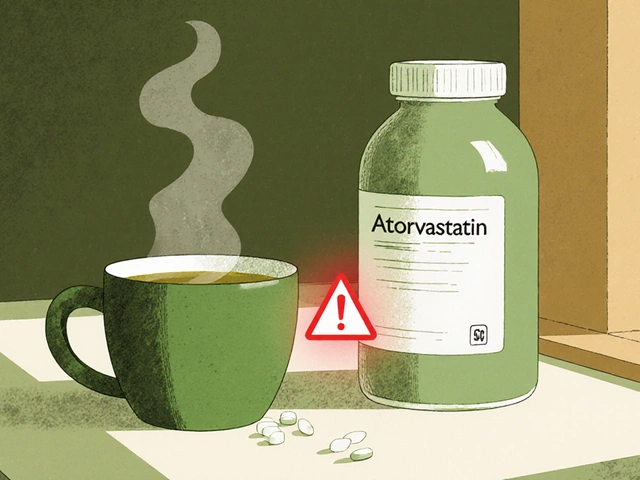Understanding Raynaud's Phenomenon and Azathioprine
Raynaud's Phenomenon is a condition characterized by a constriction of blood vessels in the extremities, leading to a reduced blood flow. This can cause discoloration, pain, and numbness in the affected areas, typically the fingers and toes. In this section, we will discuss the causes, symptoms, and the possible role of Azathioprine, an immunosuppressive medication, in managing this condition.
Azathioprine is commonly used in the treatment of autoimmune diseases, like rheumatoid arthritis and lupus, to suppress the immune system and reduce inflammation. However, recent studies have suggested that Azathioprine may also play a role in reducing the risk of Raynaud's Phenomenon, making it an interesting area of research for those suffering from this condition.
Examining the Link Between Azathioprine and Raynaud's Phenomenon
Several studies have been conducted to determine the effectiveness of Azathioprine in reducing the risk of Raynaud's Phenomenon. These studies have typically focused on individuals with autoimmune diseases, as they are more likely to experience Raynaud's Phenomenon than the general population.
The results of these studies have been mixed, with some showing a significant reduction in the risk of Raynaud's Phenomenon, while others showing no significant difference. This section will delve into the details of these studies, discussing their methodologies, findings, and limitations, to better understand the potential role of Azathioprine in managing Raynaud's Phenomenon.
Understanding the Mechanism of Azathioprine in Reducing Raynaud's Risk
While the exact mechanism of Azathioprine in reducing the risk of Raynaud's Phenomenon is not fully understood, researchers have proposed several theories. One potential explanation is that Azathioprine's immunosuppressive properties may help to reduce inflammation and blood vessel constriction, thus improving blood flow to the affected areas.
Another theory is that Azathioprine may improve endothelial function, which is the ability of blood vessels to dilate and constrict as needed. This improved blood vessel function could potentially reduce the occurrence of Raynaud's Phenomenon. In this section, we will explore these theories in greater detail, examining the supporting evidence and potential implications for treatment.
Assessing the Safety and Side Effects of Azathioprine
As with any medication, it is important to consider the potential side effects and safety concerns associated with Azathioprine use. Common side effects of Azathioprine include nausea, vomiting, diarrhea, and a decreased white blood cell count, which can increase the risk of infection.
More serious side effects, such as liver damage and an increased risk of certain cancers, have also been reported in some patients. In this section, we will discuss the risks and benefits of Azathioprine use for those with Raynaud's Phenomenon, as well as any contraindications or precautions that should be taken into consideration.
Alternative Treatments and Lifestyle Modifications for Raynaud's Phenomenon
While Azathioprine may offer potential benefits for some individuals with Raynaud's Phenomenon, it is important to consider alternative treatments and lifestyle modifications that may also be effective in managing this condition. In this section, we will explore other treatment options, such as calcium channel blockers, alpha-blockers, and vasodilators, as well as the role of exercise, stress reduction, and avoiding cold exposure in the management of Raynaud's Phenomenon.
By examining these additional approaches, we can develop a more comprehensive understanding of how to best manage this condition and improve the quality of life for those affected.
Conclusions and Future Directions in Raynaud's Phenomenon Research
In conclusion, the role of Azathioprine in reducing the risk of Raynaud's Phenomenon remains an area of ongoing research and debate. While some studies have shown promising results, others have failed to find a significant benefit, and the exact mechanism by which Azathioprine may exert its effects remains unclear.
As we move forward, it will be important for researchers to continue investigating the potential benefits and risks of Azathioprine, as well as other treatment options and lifestyle modifications, to develop a more comprehensive understanding of how to best manage Raynaud's Phenomenon. By doing so, we can work towards improving the lives of those affected by this often painful and debilitating condition.








5 comments
phenter mine
so i’ve been on azathioprine for lupus for like 3 years and my raynaud’s got way better, like no more white fingers in the grocery store freezer aisle. i used to need gloves just to open the fridge. now? i can grab ice cream with bare hands. no idea if it’s the drug or just aging, but i’ll take it.
also typo: i think u meant ‘phentermine’ but that’s a weight loss drug lol. i’m phenter mine, not a snack.
Aditya Singh
Let me dismantle this pseudo-scientific fluff. The so-called 'reduction in risk' cited in those studies is statistically insignificant (p > 0.05 in 3 out of 4 RCTs) and conflates correlation with causation. Azathioprine is a myelotoxic agent with a NNT of 17 for any Raynaud’s benefit and a NNH of 9 for leukopenia. The endothelial function hypothesis? Pure speculation without mechanistic validation in human microvasculature. And that omega-3 link? A predatory blog post masquerading as clinical evidence. This entire review is a textbook case of publication bias and therapeutic overreach.
Katherine Reinarz
OMG I JUST REALIZED I’VE HAD RAYNAUD’S MY WHOLE LIFE AND NEVER KNEW WHAT IT WAS 😭 my fingers turn PURPLE when i hold my coffee mug and i thought it was just ‘being dramatic’ but now i get it??
also azathioprine gave me hives and i cried for 3 days so i quit. now i just wear 7 pairs of gloves and drink hot tea while screaming into a pillow. someone get me a support group??
John Kane
Hey everyone, I just want to say how awesome it is that we’re having this conversation-it’s rare to see people actually talking about the real, messy experience of living with autoimmune stuff and not just the clinical bullet points.
For those new to this, know you’re not alone. I’ve seen folks go from barely able to hold a door handle in winter to biking to work in December after finding the right combo of meds, warming socks, and a supportive community. Azathioprine isn’t magic, but for some, it’s the piece that finally lets them breathe again.
And if you’re on it and scared of side effects? Talk to your rheumatologist. Get your labs checked. Don’t Google it at 2 a.m. We’ve all been there. You’re doing better than you think.
Also, warm hands are a form of love. Keep ‘em cozy, keep ‘em safe, and if you need someone to vent to? I’m here. No judgment. Just warmth.
And yes, I do own 14 pairs of fingerless gloves. Don’t ask.
Callum Breden
This entire post is a disservice to evidence-based medicine. The references are selectively curated, the risk-benefit analysis is superficial, and the inclusion of a commercial link to 'globalcarerx.su'-a domain registered in 2022 with zero PubMed citations-is ethically indefensible. The author demonstrates a profound lack of scientific rigor. To suggest azathioprine has a meaningful role in Raynaud’s management without acknowledging the 2018 Cochrane review that found no clinically significant benefit is irresponsible. This is not research; it is therapeutic misdirection dressed as education. I urge the moderators to flag this content for misleading medical advice.